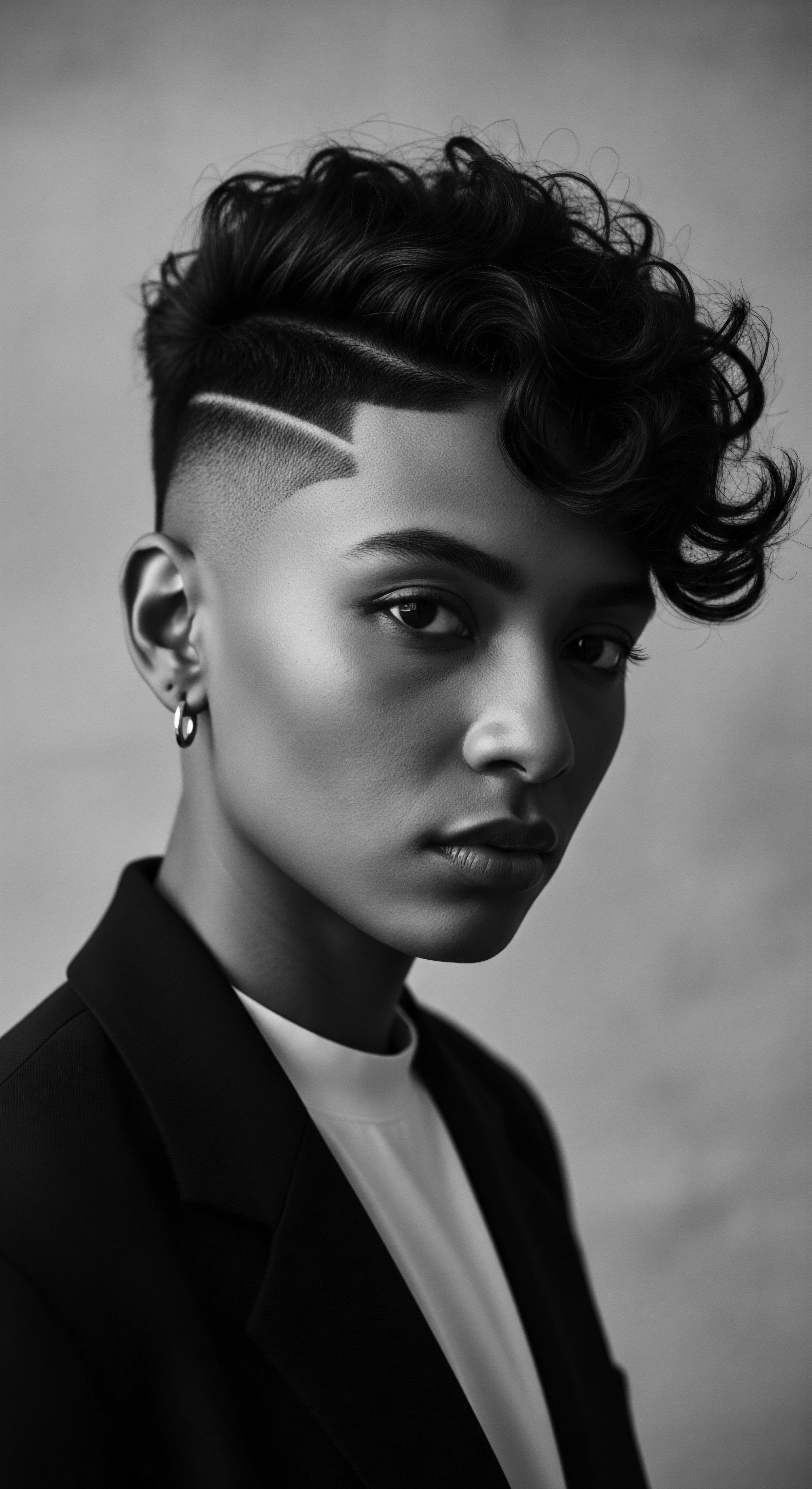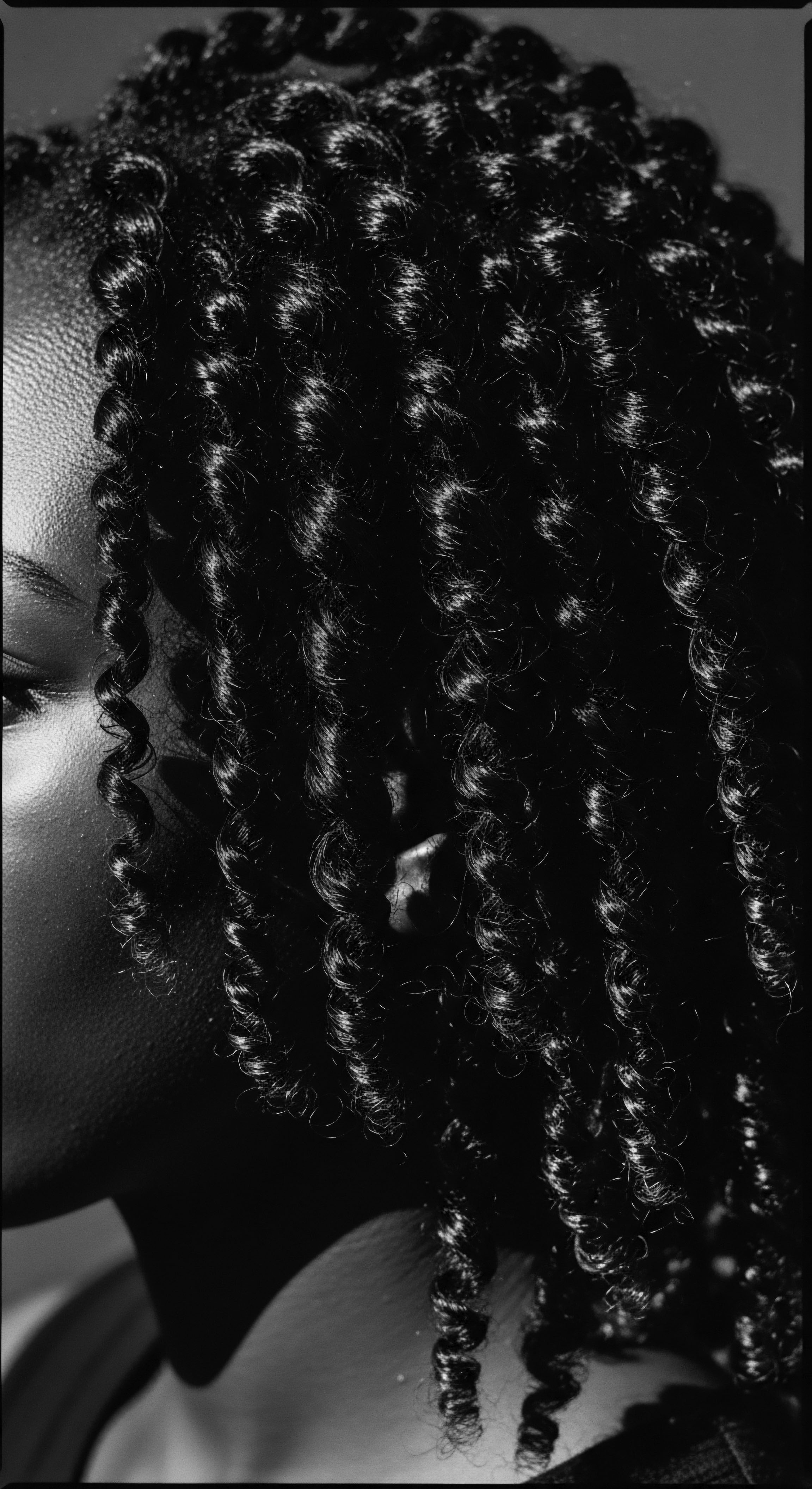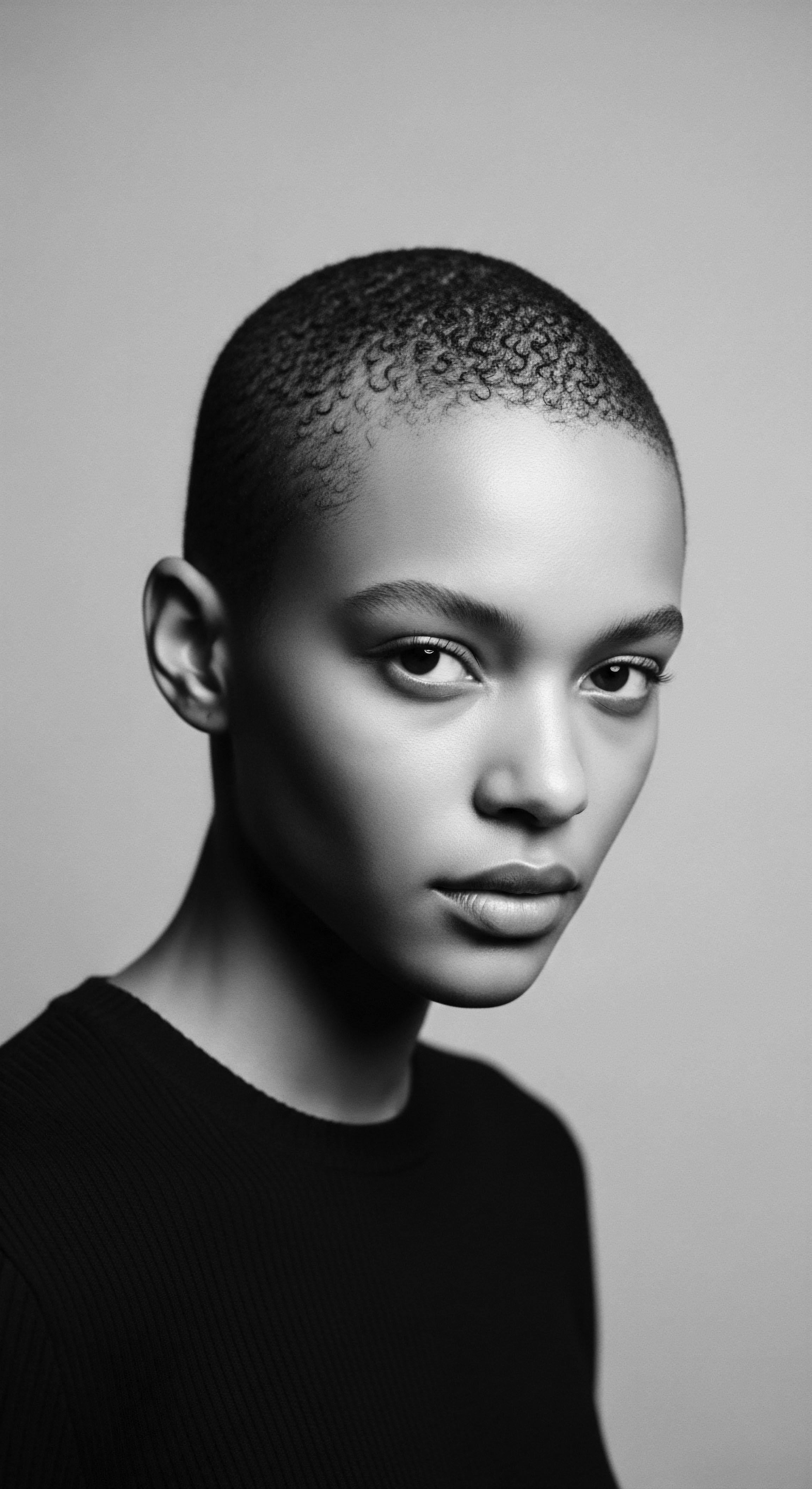
Roots
The coil, a helix spun by ancestral hands, carries within its very structure the whispers of generations, a testament to resilience, beauty, and wisdom passed through time. For those of us who journey with textured hair, our strands are not mere biological constructs; they are living archives, imbued with the rich history of Black and mixed-race peoples. To ask how ancient plants protected textured coils is to embark upon a sacred inquiry into this heritage, tracing the very earliest dialogues between humanity and the earth.
This exploration reaches into practices developed not from fleeting trends, but from deep observation, spiritual connection, and an intimate knowing of botanicals. It speaks to a time when care was ritual, when provision came directly from the soil, and when the integrity of one’s hair was intrinsically linked to identity, community, and the spirit world.

The Unfurling Strand ❉ Hair Anatomy Through an Ancestral Lens
Textured hair, with its unique elliptical or flattened follicle shape, coils and bends as it grows, creating a delicate architecture. This intricate structure, while captivating, presents specific needs ❉ a greater propensity for dryness due to the difficulty of natural oils traveling down the spiral, and a susceptibility to breakage at its many curves. From antiquity, communities recognized these distinct characteristics.
They understood, perhaps without modern microscopy, that coily hair demanded a particular kind of guardianship, a protection that plant life offered with profound generosity. The earliest forms of hair care were not about cosmetic appeal alone; they were about preservation in challenging environments and maintaining the very health of the strand.
Ancient practices of hair care were foundational acts of preservation, shaped by an intrinsic understanding of textured coils and their environmental needs.
Consider the dry, arid climates across parts of Africa, where sun and wind could quickly compromise the integrity of exposed hair. Here, plant mucilages, rich botanical oils, and nourishing butters emerged as indispensable guardians. These natural offerings acted as barriers, sealants, and profound conditioners.
The wisdom of discerning which plant possessed which specific property was a knowledge held, shared, and evolved over countless generations. It was a science rooted in empiricism, observation, and communal transmission.

What Did Early Hair Classifications Reveal About Plant Use?
While modern hair typing systems categorize curls into specific patterns, ancient communities did not possess such formal taxonomies. Their understanding of hair varied, often connected to social status, tribal affiliation, and spiritual belief. Despite the absence of a universal classification, the practices of protection remained remarkably consistent for highly textured hair. The focus was on maintaining length and health, and plants were central to this endeavor.
Hair was a marker of identity and well-being, and its care was therefore paramount. (Leach, 1958). The methods of protection often transcended simple application; they became interwoven with daily life and significant ceremonies.
- Aloe Vera ❉ Valued across ancient Egypt and parts of Africa for its soothing and moisturizing properties, it addressed scalp dryness and irritation.
- Castor Oil ❉ A staple in ancient Egyptian hair routines, known for its ability to condition, strengthen, and promote the appearance of thickness.
- Henna ❉ Used for centuries across North Africa, the Middle East, and India not only for natural color but also for its strengthening qualities.
- Shea Butter ❉ A foundational ingredient from West Africa, applied to moisturize and shield hair from harsh environmental conditions.
These are but a few examples, highlighting a shared knowledge base across diverse geographical regions, each drawing upon their local flora to address the fundamental requirements of maintaining textured strands.

Ritual
The daily and ceremonial acts of caring for textured coils were not incidental; they were intentional rituals, deeply embedded in the rhythm of life and the heritage of community. These practices, honed over millennia, reveal a sophisticated understanding of botanical properties and their synergistic effects on hair. The application of ancient plant-based remedies was often part of a communal process, reflecting shared wisdom and intergenerational bonds.

How Did Protective Styling Benefit From Botanical Ingredients?
Protective styles, such as braids, twists, and locs, were not merely aesthetic choices in ancient African and diasporic communities. They served a vital purpose ❉ shielding delicate coils from environmental damage, reducing manipulation, and preserving length. Plant-derived oils, butters, and powders played an indispensable role in preparing and maintaining these styles. The inclusion of these natural elements ensured that hair remained supple, moisturized, and resilient even when tucked away for extended periods.
The very act of braiding often began with an anointing of oils and balms, conditioning the hair for its protected state. (Ademefun, 2020).
| Botanical Ingredient Coconut Oil |
| Traditional Application in Styling Pre-treatment before braiding to soften and prepare strands. |
| Contemporary Understanding of Benefit Penetrates the hair shaft to reduce protein loss and provide deep moisture. |
| Botanical Ingredient Jojoba Oil |
| Traditional Application in Styling Sealant after styling to add shine and protection. |
| Contemporary Understanding of Benefit Mimics natural scalp sebum, balancing moisture and shielding strands. |
| Botanical Ingredient Baobab Oil |
| Traditional Application in Styling Applied as a leave-in for intense moisture in coiled styles. |
| Contemporary Understanding of Benefit Rich in vitamins A, D, E, F and omega-3 fatty acids, aids damage repair. |
| Botanical Ingredient Rhassoul Clay |
| Traditional Application in Styling Used as a hair wash to cleanse without stripping natural oils, enhancing curl definition. |
| Contemporary Understanding of Benefit Possesses strong cleansing properties, removing impurities while leaving hair conditioned. |
| Botanical Ingredient These plant-based practices provided foundational care, allowing intricate styles to thrive and preserving the hair's inherent strength across diverse heritage traditions. |

The Living Legacy of Chebe Powder in Chadian Hair Heritage
A powerful instance of ancient plants protecting textured coils hails from the Basara Arab women of Chad, known for their remarkably long, resilient hair. For centuries, these women have used Chebe Powder, a traditional remedy derived primarily from the Croton gratissimus shrub, along with other ingredients such as mahleb, missic stone, and cloves. This plant-based mixture is not a growth stimulant in the sense of increasing follicle production, but it acts as a phenomenal moisture sealant.
The powder is typically mixed with oils and applied to the hair, coating the strands from roots to tips, often as part of a protective style. The application allows moisture to be locked into the hair shaft, significantly reducing breakage and split ends, which in turn permits the hair to retain its length.
The cultural significance of chebe powder extends beyond its practical benefits. It is a symbol of identity, tradition, and pride within Chadian culture. The ritual of its application often involves communal bonding, reinforcing intergenerational ties and shared beauty customs. (Sevich, 2023).
This enduring practice, passed down through countless generations, stands as a vibrant example of how communities developed sophisticated plant-based solutions to safeguard textured coils against harsh environmental conditions, achieving length and vitality. The consistency of this ancient application highlights a deep, ancestral understanding of hair’s specific needs.
The Basara Arab women’s continuous use of chebe powder illustrates centuries of plant-based innovation for length retention and cultural identity.
It is a testament to natural solutions’ efficacy that this practice has persisted without external commercial validation for so long, gaining global recognition today based on its demonstrable results and the length of the hair maintained by these women.

Relay
The wisdom carried forward from ancient hair care practices, particularly those involving plants, offers a profound understanding of holistic well-being for textured coils. This is not merely an antiquated curiosity; it is a vital lineage of knowledge that continues to inform and inspire contemporary approaches to hair health, particularly within Black and mixed-race communities. The intricate interplay of botanical chemistry, traditional technique, and cultural significance represents a sophisticated system of care that modern science is only now fully appreciating.

How Do Plant Mucilages Offer Protection to Coils?
One of the most remarkable properties of certain ancient plants, pivotal for textured hair, is their capacity to produce mucilage. Mucilage is a thick, gelatinous substance, a polysaccharide, secreted by various plants for functions like water storage and seed dispersal. When applied to hair, this sticky, slippery material acts as a natural humectant and emollient. It draws moisture from the air and seals it into the hair shaft, providing unparalleled hydration.
This effect is particularly beneficial for coily hair, which often struggles with dryness due to its structural pattern. The mucilage coats the hair, creating a protective film that reduces friction, helps with detangling, and provides a slip that prevents mechanical breakage during styling and manipulation.
Historically, plants like Okra (Abelmoschus esculentus) and Hibiscus (Hibiscus rosa-sinensis) were prized for their mucilaginous content. The slimy extract from okra pods or hibiscus leaves, steeped in water, created a conditioning rinse. This ancestral knowledge is increasingly validated by modern chemistry, which identifies the polysaccharides responsible for these conditioning effects. The use of such botanical humectants predates synthetic conditioners by millennia, highlighting an intuitive, deeply experiential grasp of what textured hair required for optimal health.
- Okra ❉ Its mucilage-rich pods, when boiled, yield a slick substance used as a natural conditioner, enhancing slip and moisture.
- Flaxseed ❉ A source of lignans and mucilage, flaxseed gel provides hold, moisture, and definition to curls without stiffness.
- Slippery Elm ❉ The inner bark of this tree, when steeped, releases a mucilaginous liquid that detangles and softens coiled strands.
These are simple ingredients, yet their impact on coil integrity is profound, offering a protective shield that promotes elasticity and reduces breakage.

What Was The Ancestral Approach to Nighttime Coil Protection?
The commitment to preserving textured coils extended beyond daytime rituals into the sacred hours of rest. Nighttime protection was, and remains, a cornerstone of maintaining hair health, particularly for patterns prone to tangling and moisture loss from friction. Ancient communities understood the need to shield hair from the elements, including abrasive surfaces during sleep. While the modern satin bonnet or silk scarf is a relatively recent innovation, the underlying principle of protecting the hair, especially delicate coils, was deeply rooted in ancestral practice.
One might find historical accounts of headwraps, cloths, or even woven caps used to cover hair before sleep. These coverings served multiple purposes ❉ maintaining moisture applied during the day, protecting intricate styles, and safeguarding the hair from dust or environmental aggressors. The materials, often natural fibers, would have varied by region, but the intent remained constant—to create a nocturnal sanctuary for the strands.
This consistent care reduced daily manipulation and breakage, contributing to length retention and overall hair strength. The awareness of how daily life affected hair, even during sleep, speaks to a comprehensive, inherited understanding of textured hair’s vulnerabilities and needs.
Nighttime protection rituals, even without modern tools, were a testament to ancestral care, safeguarding delicate coils from damage and preserving applied moisture.
The continuity of these practices, from ancient cloth wraps to contemporary satin-lined bonnets, demonstrates a persistent, cross-generational wisdom for safeguarding coiled hair.

Reflection
To contemplate how ancient plants protected textured coils is to peer into a profound wellspring of heritage, one that transcends mere botanical science and touches the very Soul of a Strand. Each coil, each curve, carries the ancestral memory of resilience, innovation, and an intimate connection to the earth’s bounty. The protective qualities of plants — their humectant mucilages, their sealing oils, their strengthening powders — were not discovered through laboratory experimentation, but through generations of lived experience, keen observation, and reverence for nature’s offerings. This historical arc reveals that the care for textured hair was, and continues to be, a living library of wisdom, passed from elder to child, from hand to coil.
Our journey through these ancient practices reminds us that true wellness for textured hair is never divorced from its roots. It calls upon us to recognize the deep scientific principles inherent in what our forebears intuitively knew, to honor the cultural significance embedded in every traditional remedy, and to carry forward this luminous heritage with respect and pride. The enduring legacy of ancient plants protecting textured coils is a powerful affirmation of self-sufficiency, a celebration of inherited beauty, and a continuous invitation to reconnect with the ancestral rhythms that shaped our hair’s magnificent story.

References
- Ademefun, Sharon. (2020). Rona Wigs ❉ The Purpose of Protective Styling.
- Leach, Edmund. (1958). Magical Hair. The Journal of the Royal Anthropological Institute of Great Britain and Ireland.
- Sevich. (2023). The Cultural Background and History of Chebe Powder.
- Akinwunmi, O. (2019). Ethnobotany of Hair Care ❉ Traditional Plant Uses in African Communities. Journal of Traditional Medicine.
- Bennett, R. (2021). Botanical Benefits ❉ A Deep Dive into Natural Ingredients for Hair. Herbal Science Review.
- Chandra, S. (2022). Polysaccharides in Cosmetics ❉ The Role of Plant Mucilages in Hair Care. International Journal of Cosmetic Science.
- Davila, C. (2020). The Historical Significance of Oils in Global Beauty Practices. Cultural Anthropology Quarterly.
- Jones, L. (2023). African Hair Traditions ❉ A Guide to Ancient Practices and Modern Adaptations. University Press.
- Smith, K. (2021). Indigenous Hair Rites ❉ A Study of Care and Identity. Journal of Ethnobiology.
- Williams, D. (2024). Coiled Wisdom ❉ Ancestral Hair Care and Its Enduring Legacy. Heritage Publishing.
